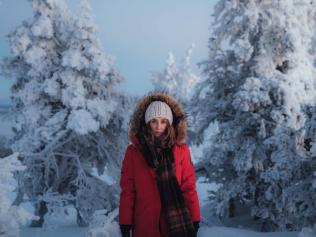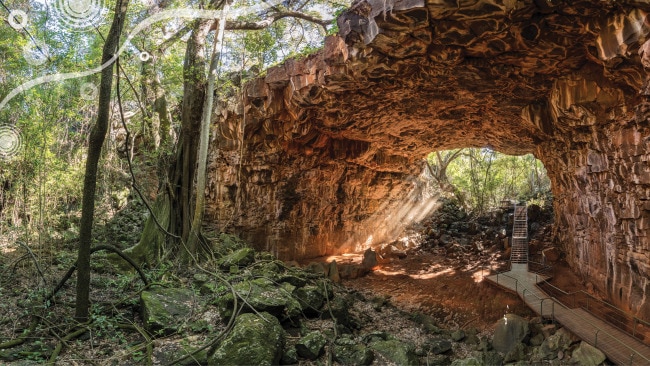How to take better travel photos
The world’s most famous landmarks tend to be shot

When you’re on holiday, your photos will probably look like everyone else’s. Here’s how to take better travel photos and up your ‘gram game.
Over 1.2 million people follow her every move, yet Emilie Ristevski rarely shows her face.
"It's one thing I've chosen to be conscious about and a style I've developed over many years," the 26-year-old says. "Personally, I’m an introverted person and I’ve always preferred to be behind the camera. As my photography style developed I realised I didn’t want my imagery to be purely about myself. I wanted to focus on the experiences and the beauty of our world."
Emilie is the face behind the camera, a new breed of travel photographer, capturing the landscapes from New Zealand to Tasmania and Iceland to Peru in her distinctive style and sharing them on her wildly popular Instagram @helloemilie. Only six years ago, Emilie was a uni student studying design. Today, she is commissioned by clients and tourism boards to capture imagery in her distinctive aesthetic which she describes as “dreamy, surreal and landscape inspired".
How do you take better travel photographs that'll up your 'gram game? Emilie says you don't need the best gear to become a better photographer — you can improve your skills with just a few tips.
INVEST IN GOOD TOOLS
For professional work, Emilie says some images will take over an hour adjusting using Adobe Lightroom on her computer. Editing should subtly improve an image but never drastically change a scene — good editing is something you don't see.
For Instagram stories, Emilie makes small modifications from her phone.
"Useful apps on your phone will really help bring your shots to life," she says. "Adobe Lightroom on mobile is a great app, the tools can really help to enhance your images. There are a few others that I like to use (such as) VSCO or Unfold, which are great for layouts for your Instagram stories and placing text together to share your message."
The Canon EOS M50 as a good option for people starting out. It’s compact, making it perfect for travelling and you can send photos directly to your phone to share on the ‘gram.
“For anyone interested in further developing their photography skills, I recommend the 6D Mark II,” she says. “I also suggest investing your savings into higher quality lenses over the choice of the camera itself, as lenses can significantly help to improve your photography. One of my most used L series lens (24-70mm f/2.8L II) has been with me for well over the last five to seven years and is one of my favourite pieces of equipment I still use today.”
PRACTICE MAKES PERFECT
Emilie discovered her passion for photography during a film photography class in high school although never trained professionally. She says anyone can navigate the manual settings of their camera, it just takes time and practice.
"I’ve been shooting on a Canon for over 10 years. Surprisingly, there are still things and little settings that you can learn," she says. "Practising is the most important thing you can do — just get out there."
She says relying on the Auto setting will often result in images that miss the mark. When you learn how to master the manual settings of your camera, you take creative control of the shutter speed, aperture, and ISO, which affects the focus, overall mood and quality of the shot. Understanding how these three settings work together can feel overwhelming at first, but that shouldn't be a reason to stop shooting.
Online tutorials outline the basics of photography, as well as tutorials designed for specific camera models, like Canon's Camera Assist. There are also real-life classes run by Canon Collective, a series of workshops designed to develop your photography skills in a relaxed, hands-on environment. Some are even free, others cost around $20. Bottom line: Now's the time to wean yourself off Auto settings.
GET UP EARLY… OR HANG AROUND 'TILL SUNDOWN
Known as the 'golden hour' for photographers, early morning or late evening are the best times of day to capture as the light is soft, colours pop, and a landscape comes to life. This compares to the middle of the day, where natural light tends to be harsh and can risk over-exposure.
"I feel like I'm always chasing light," Emilie says. "Lighting is the most important element of my imagery. It can literally change how an image is captured, the mood, the colours, everything. Understanding how light works is crucial."
She recommends travellers plan a sunrise or sunset strategy for at least one day of their holiday — it's likely you'll stumble across something other travellers might miss.
"My favourite time is just before sunrise or just after sunset when the sun is below the horizon. It only lasts a few moments before it disappears when there is such a beautiful glow on the horizon," Emilie says.
FIND THE STORY
Forever wandering with a camera in her hand, Emilie has explored so many countries she has lost count.
"I am really drawn to the unknown, remote locations, places that you need to discover and have some sort of curiosity about them," she says. "I've been hosting photography tours in Namibia, Africa — the landscapes there are literally mind-blowing. The endless Kalahari Desert has the highest sand dunes in the world and its wildlife is so special."
There are the formal elements of design — lines, depth of field, texture, symmetry and pattern — that work together to create a striking image, but Emilie says it's the intention of the shot that's the most important.
"Think about the message you're trying to share," she recommends. "There are so many images out there, but the most important images I’ve captured are the ones of the people I've met and the story behind them. When I travel, I like to understand a destination from a local perspective and hear the stories behind the location. I hope to focus on these details to be able to share more meaningful content on my platform."
A connection with the subject, whether it's someone you know or a stranger, will make them feel at ease and relax in front of the camera. In an age of endless scrolling and cloud storage, it's a nice gesture to print your photos and send them to the people you share your holiday with — a memento to stick on the fridge or hang on the wall to remember forever. Get back to the pre-Insta age: Print your holiday photos, stick them in an album and write captions so you'll personally remember those small moments decades later.
REMEMBER TO APPRECIATE THE MOMENT, TOO
Social media has accelerated Emilie’s career, taken her to far-flung places around the world, connected her with strangers and people from all parts of the world. Despite her life being so intertwined with the app, she says it's important to remember to put the camera down, disconnect from social media and enjoy the moment.
"At the end of February, I went to Greenland during the middle of winter. To travel to the final destination, I took three flights from Europe and then a helicopter. I ended up flying small remote village, and I remember looking down on the tiny island, frozen in the middle of the ocean, on one of the most remote parts of our planet thinking, 'This is surreal, how on earth am I here?'," she recalls. "I didn't even reach for my camera, I just wanted to appreciate that moment. It's a feeling I'll remember for a very long time."
Originally published as How to take better travel photos


